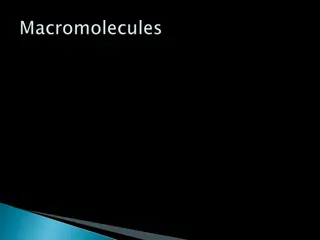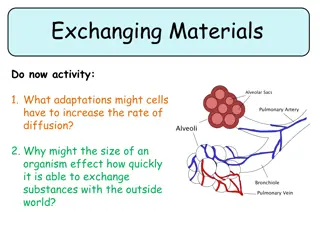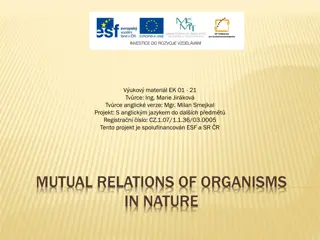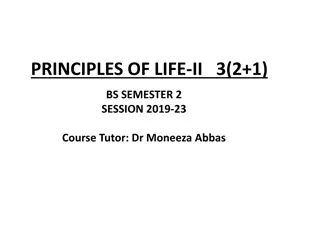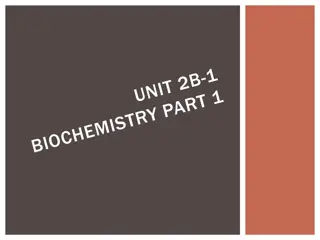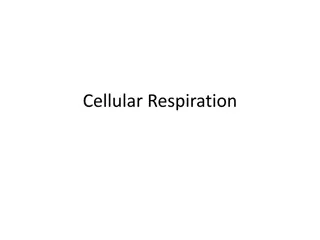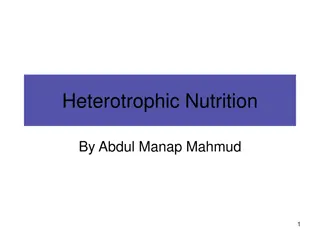Bioelements in Living Organisms
Bioelements are chemical elements crucial for the molecules in living organisms. They include major elements like oxygen, carbon, hydrogen, and trace elements such as iron, zinc. These elements play essential roles in maintaining growth, development, and health across different organisms. Understanding the significance of macrominerals and micronutrients is vital for overall well-being.
Uploaded on Sep 16, 2024 | 0 Views
Download Presentation

Please find below an Image/Link to download the presentation.
The content on the website is provided AS IS for your information and personal use only. It may not be sold, licensed, or shared on other websites without obtaining consent from the author.If you encounter any issues during the download, it is possible that the publisher has removed the file from their server.
You are allowed to download the files provided on this website for personal or commercial use, subject to the condition that they are used lawfully. All files are the property of their respective owners.
The content on the website is provided AS IS for your information and personal use only. It may not be sold, licensed, or shared on other websites without obtaining consent from the author.
E N D
Presentation Transcript
Unit 1: Biology Introduction Topic: Bio Elements Concept B.Ed (Hons) Secondary Semester: I Subject: Biology I (Minor) Course Title: General Biology Represented By: Ms Sidra Younis Department of Education (Planning and Development) Lahore College for Women University, Lahore
BIOELEMENT Any chemical element that is found in the molecules and compounds that make up a living organism. In the human body the most common bioelements (in decreasing order of occurrence) are oxygen, carbon, hydrogen, nitrogen, calcium, and phosphorus. Other bioelements include sodium, potassium, magnesium, and copper. Essential element Any of a number of elements required by living organisms to ensure normal growth, development, and maintenance. Apart from the elements found in organic compounds (i.e. carbon, hydrogen, oxygen, and nitrogen), plants, animals, and microorganisms all require a range of elements in inorganic forms in varying amounts, depending on the type of organism.
CONT. The major elements, present in tissues in relatively large amounts (greater than 0.005%), are calcium, phosphorus, potassium, sodium, chlorine, sulphur, and magnesium (see also macronutrient). Macro Elements Macro elements are the natural elements of which the body needs more amount and are more important than any other minerals. Macrominerals includes sodium (Na), potassium (K), calcium (Ca), and magnesium (Mg) which are cations; and two chlorine (Cl) and phosphorus (P) which are accompanying anions. Macrominerals such as sodium and potassium are electrolytes and the body uses electrolytes to maintain acid-base balance and fluid balance (homeostasis) and for normal neurological, myocardial, nerve, and muscle function.
CONT. The trace elements occur at much lower concentrations and thus requirements are much less. The most important are iron, manganese, zinc, copper, iodine, cobalt, selenium, molybdenum, chromium, and silicon (see also micronutrient). Each element may fulfil one or more of a variety of metabolic roles. Sodium, potassium, and chloride ions are the chief electrolytic components of cells and body fluids and thus determine their electrical and osmotic status. Micro Elements Microelements are essential elements required by organisms in varying quantities throughout life to orchestrate a range of physiological functions to maintain health.Micronutrient requirements differ between organisms; for example, humans and other animals require numerous vitamins and dietary minerals,whereas plants require specific minerals.For human nutrition, micronutrient requirements are in amounts generally less than 100 milligrams per day, whereas macronutrients are required in gram quantities daily.
CONT. The minerals for humans and other animals include 13 elements that originate from Earth's soil and are not synthesized by living organisms, such as calcium and iron.Micronutrient requirements for animals also include vitamins, which are organic compounds required in microgram or milligram amounts. Since plants are the primary origin of nutrients for humans and animals, some micronutrients may be in low levels and deficiencies can occur when dietary intake is insufficient, as occurs in malnutrition, implying the need for initiatives to deter inadequate micronutrient supply in plant foods. A multiple micronutrient powder of at least iron, zinc, and vitamin A was added to the World Health Organization's List of Essential Medicines in 2019
CONT. Calcium, phosphorus, and magnesium are all present in bone. Calcium is also essential for cell signalling and nerve and muscle activity, while phosphorus is a key constituent of the chemical energy carriers (e.g. ATP) and the nucleic acids. Sulphur is needed primarily for amino acid synthesis (in plants and microorganisms). The trace elements may serve as cofactors or as constituents of complex molecules, e.g. iron in haem and cobalt in vitamin B12. Trace Elements Trace elements (or trace metals) are minerals present in living tissues in small amounts. Some of them are known to be nutritionally essential, others may be essential (although the evidence is only suggestive or incomplete), and the remainder are considered to be nonessential.
CONT. Trace elements function primarily as catalysts in enzyme systems; some metallic ions, such as iron and copper, participate in oxidation-reduction reactions in energy metabolism. Iron, as a constituent of hemoglobin and myoglobin, also plays a vital role in the transport of oxygen. All trace elements are toxic if consumed at sufficiently high levels for long enough periods. The difference between toxic intakes and optimal intakes to meet physiological needs for essential trace elements is great for some elements but is much smaller for others. Essential trace elements of the human body include zinc (Zn), copper (Cu), selenium (Se), chromium (Cr), cobalt (Co), iodine (I), manganese (Mn), and molybdenum (Mo). Although these elements account for only 0.02% of the total body weight, they play significant roles, e.g., as active centers of enzymes or as trace bioactive substances.
CONT. A major outcome of trace element deficiencies is reduced activity of the concerned enzymes. However, since each trace element is related to so many enzymes, deficiency of a single trace element is often not associated with any specific clinical manifestations, but rather manifests as a combination of various symptoms. Because of the presence of trace elements in very small amounts and the absence of specific clinical features associated with their deficiency, it is often difficult for clinicians to identify deficiencies of some particular trace elements
PERCENTAGES OF BIO-ELEMENTS BY MASS IN HUMAN BEING Out of 92 naturally occurring chemical compounds, only 16 are bio-elements and out of these 16 only 6 account for 99% of the total mass in human body. Oxygen Carbon Hydrogen Nitrogen Calcium Phosphorous Potassium Sulphur Chlorine Sodium Magnesium Iron Some elements like Copper, Manganese, Zinc and iodine are present in Traces. 65% 18% 10% 3% 2% 1% 0.35% 0.25% 0.15% 0.15% 0.05% 0.004%












